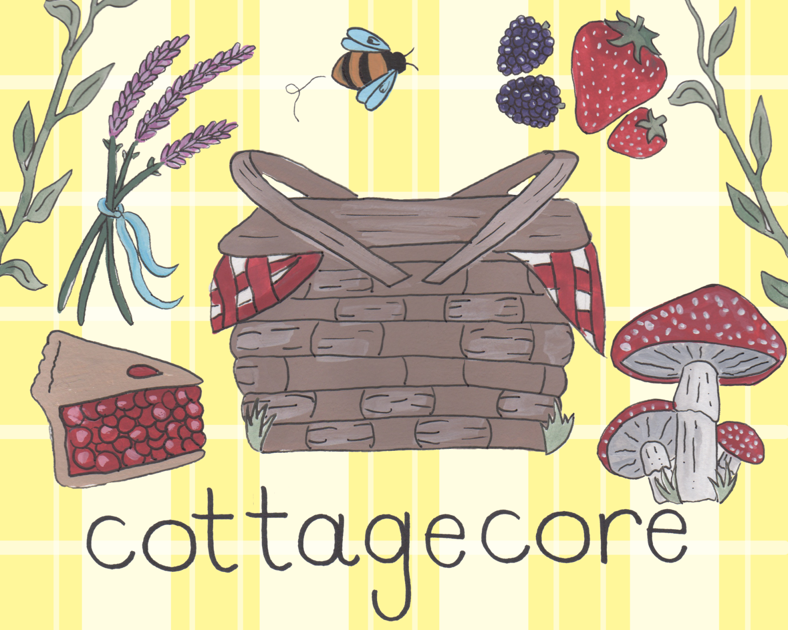Nicewaner: Cottagecore | Opinion | the-standard.org - Standard Online
- Get link
- X
- Other Apps

After deciding to finally purchase the popular video game Stardew Valley and spending my entire spring break religiously playing it, the hype surrounding this farming simulation game began to make complete sense to me. Taking place in a rural area near a small town, players can explore the open countryside amongst other townsfolk with the ability to farm, fish, raise animals and more.
Other admired video games, such as Animal Crossing — a simulation game where players can chop wood, grow fruit trees and tend gardens amongst animal villagers — also romanticize living an old-fashioned, cozy life in nature.
In the last decade, the picturesque, countryside lifestyle, much like the lifestyle players can live out in Stardew Valley and Animal Crossing, has become an obsession amongst Generation Z, so much so that it has its own name: cottagecore.
Cottagecore — the "core" suffix deriving from the phrase "hard core" and associated with devoted enthusiasts — is an aesthetic centered around an ethereal, rustic lifestyle inspired by English cottages from the late 18th and early 19th centuries.
"It's a style that is very connected to nature and creation," sophomore communication sciences and disorders major Lauren Mercer said. "It's focused on art, flowers, pastels, gardens and light. In my mind, it centers on growth, both literal growth through nature and metaphorical self-growth."
Whether it's making your own sourdough starter, composting leftover fruits and vegetables from your kitchen or flaunting a frilly dress in an open pasture — "Sound of Music" style — cottagecore is undoubtedly our generation's most beloved escapist fantasy fixation.
First gaining popularity on Tumblr, cottagecore has reached internet obsession on newer social media platforms as well, such as TikTok, with over 5.2 billion videos posted on the app under the hashtag, "cottagecore."
During the summer of 2020, trend expert at Tumblr Amanda Brennan told Vox the cottagecore hashtag shot up 153% on Tumblr, while likes on posts about cottagecore went up 541% during March and April of 2020, the beginning of COVID-19 lockdowns for many Americans.
There's even a "What Percent Cottagecore Are You?" Buzzfeed quiz people can take to find out how cottagecore they really are. While it's obvious the internet — namely, Generation Z — has romanticized living a homey, rustic life out in the country, what exactly makes this aesthetic so appealing?
Sophomore professional writing major Meg Keller, who owns over 30 house plants, composts daily and wears secondhand, "grandma-ish" clothes, said cottagecore provides a sense of comfort for her when modern life seems unappealing.
"I used to think the ideal, dream future was being rich and working, but instead of dreaming of working, I dream of living in an ethereal cottage in a field of wildflowers, where I can wear frilly dresses and feed chickens," Keller said. "Our generation likes it so much because we aren't as keen on sitting in an office all day, everyday, and we're beginning to stray from our parents' and grandparents' capitalist norms."
For many people, the pandemic spurred intense feelings of dissatisfaction with modern life. After witnessing the death of over half a million people from COVID-19, undergoing a tumultuous political climate — including an insurrection at the United States Capitol — and enduring financial insecurity and economic distress caused by the pandemic, running away to a peaceful cottage in the forest surrounded by plants and animals seems like the perfect escape we all desperately need.
Other Generation Z communities have also found solace in the cottagecare aesthetic, including LGBTQ+ folk. The "cottagecore lesbian" — "a girl who runs off to the countryside to live in a cottage with her lesbian wife," according to Urban Dictionary — has become a foundational identity of cottagecore subculture. On TikTok, there are over 55 million videos posted with the hashtag, "cottagecore lesbian."
Many users on Twitter have credited "Barbie & the Diamond Castle" — a 2008 animated film that tells the story of Barbie, a.k.a. Princess Liana, and her best friend Princess Alexa who share a cottage in the forest — as an important representation of the cottagecore lesbian aesthetic.
Whether you identify as a cottagecore lesbian or fall into the other niche aesthetics associated with cottagecore — such as faeriecore, grandmacore and naturecore — cottagecore is the quaint, bucolic dream everyone wishes they could play out in real life.
While some strive to live the perfect cottagecore life, it's more an idealization than something that can be easily executed in real life. The realities of living off the land and taking care of a farm in modern society are more challenging than some might think.
"It's really hard to live a full cottagecore lifestyle because it isn't necessarily on par with the common lifestyles we're used to living," Keller said. "We have to work and need jobs to continue living, which is a major challenge. In my experience, taking care of plants can be a lot of time, money and work, but ultimately, it's rewarding."
Most people probably won't get the opportunity to live a full cottagecore lifestyle, but the implementation of small, less demanding habits in your daily routine — like going on nature walks, reducing your waste or growing a plant — make you just as cottagecore as anybody else.
As we all continue to ride out this pandemic wave, mentally escaping to a serene, farm life fantasy might be exactly the remedy you need to make life more manageable. Try throwing on that flowy, vintage dress you bought from a thrift store that's been sitting in your closet for a year, find a grassy field to sprawl out in and bask in the sun; I know I'm going to.
Follow Paige Nicewaner on Twitter, @indienerdtrash
Subscribe to The Standard's free weekly newsletter here.
- Get link
- X
- Other Apps
Comments
Post a Comment